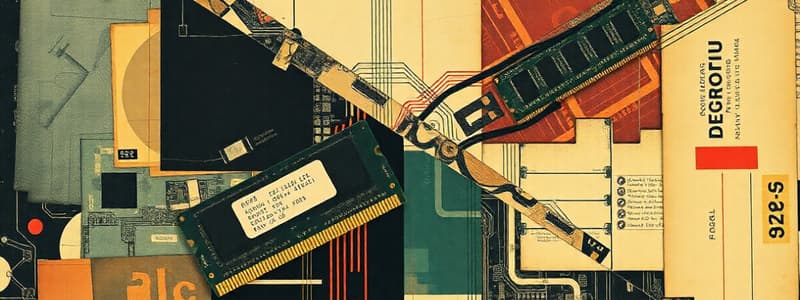Podcast
Questions and Answers
What is the primary function of the bootstrap loader stored in Read Only Memory (ROM)?
What is the primary function of the bootstrap loader stored in Read Only Memory (ROM)?
- To start up the computer (correct)
- To execute data fetch instructions
- To enhance the speed of primary memory
- To provide temporary storage for programs
Which type of Read Only Memory (ROM) can be erased using ultraviolet light?
Which type of Read Only Memory (ROM) can be erased using ultraviolet light?
- EPROM (correct)
- Flash ROM
- EEPROM
- PROM
What distinguishes Flash ROM from other types of ROM?
What distinguishes Flash ROM from other types of ROM?
- It can be programmed using ultraviolet light
- It can be reprogrammed while still in the computer (correct)
- It is only usable during boot-up
- It requires removal from the computer for reprogramming
What is a key characteristic of secondary storage?
What is a key characteristic of secondary storage?
Which of the following is NOT a type of Read Only Memory (ROM)?
Which of the following is NOT a type of Read Only Memory (ROM)?
What is the main function of the address bus in a CPU?
What is the main function of the address bus in a CPU?
Which characteristic distinguishes secondary storage from primary storage?
Which characteristic distinguishes secondary storage from primary storage?
Which of the following statements about EEPROM is true?
Which of the following statements about EEPROM is true?
How does the data retention of SRAM differ from DRAM?
How does the data retention of SRAM differ from DRAM?
What is the access time range for EPROM?
What is the access time range for EPROM?
What role does the DRAM controller play?
What role does the DRAM controller play?
Which statement best describes PROM?
Which statement best describes PROM?
What is a common feature of secondary storage devices?
What is a common feature of secondary storage devices?
What is a key feature of DDR2 SDRAM compared to DDR SDRAM?
What is a key feature of DDR2 SDRAM compared to DDR SDRAM?
Which of the following statements is true regarding RAM?
Which of the following statements is true regarding RAM?
What is a characteristic of secondary storage compared to primary storage?
What is a characteristic of secondary storage compared to primary storage?
Which statement accurately describes Random Access Memory (RAM)?
Which statement accurately describes Random Access Memory (RAM)?
What type of memory is typically considered volatile?
What type of memory is typically considered volatile?
What is the primary characteristic of Read Only Memory (ROM)?
What is the primary characteristic of Read Only Memory (ROM)?
How does DDR SDRAM achieve data transfer efficiency?
How does DDR SDRAM achieve data transfer efficiency?
What differentiates SRAM (Static RAM) from DRAM (Dynamic RAM)?
What differentiates SRAM (Static RAM) from DRAM (Dynamic RAM)?
Which of the following is NOT a characteristic of ROM?
Which of the following is NOT a characteristic of ROM?
What is the purpose of using higher frequency I/O buffers in DDR2 SDRAM?
What is the purpose of using higher frequency I/O buffers in DDR2 SDRAM?
What aspect of DDR SDRAM contributes to improved signal integrity?
What aspect of DDR SDRAM contributes to improved signal integrity?
Flashcards are hidden until you start studying
Study Notes
CPU Memory Access
- The CPU utilizes an address bus to send a memory address, indicating the desired data location.
- The CPU reads or writes data using a data bus.
Memory Types
- Memory is divided into RAM (Random Access Memory) and ROM (Read Only Memory).
- RAM is volatile, meaning data is lost when power is turned off.
- ROM is non-volatile, retaining data even when power is off.
RAM Types
- The RAM family includes SRAM (Static RAM) and DRAM (Dynamic RAM).
- SRAM retains data as long as power is applied.
- DRAM has a short data lifetime, typically lasting about four milliseconds, even with power.
- DRAM controllers refresh the data before it expires, ensuring data is maintained.
- DDR1 SDRAM, DDR2 SDRAM, and DDR3 SDRAM are types of DRAM with increasing data transfer rates.
DDR RAM
- DDR1 SDRAM uses double pumping to transfer data on both clock edges, reducing clock frequency.
- DDR2 SDRAM performs four transfers per clock, doubling the bandwidth through multiplexing.
- DDR3 SDRAM implements even faster data rates and increased memory capacity.
ROM Types
- ROM is a non-volatile storage medium where data cannot be modified.
- PROM (Programmable Read Only Memory) is empty at manufacture and can be programmed by the user.
- EPROM (Erasable Programmable Read Only Memory) can be programmed, erased, and reprogrammed using ultraviolet light.
- EEPROM (Electrically Erasable Programmable Read Only Memory) can be reprogrammed electrically without requiring ultraviolet light.
- Flash ROM is similar to EEPROM but can be reprogrammed while in the computer, making program upgrades easier.
Secondary Storage
- Secondary storage is any storage outside of primary memory and is non-volatile, large, cheap, and slow.
- Hard disks are commonly used as secondary storage.
- Secondary storage uses a file system to organize data into files and directories, providing metadata.
Bootstrap Loader
- ROM stores a program called the bootstrap loader, which helps start the computer.
- ROM has an access time between 10 to 50 nanoseconds.
Studying That Suits You
Use AI to generate personalized quizzes and flashcards to suit your learning preferences.




